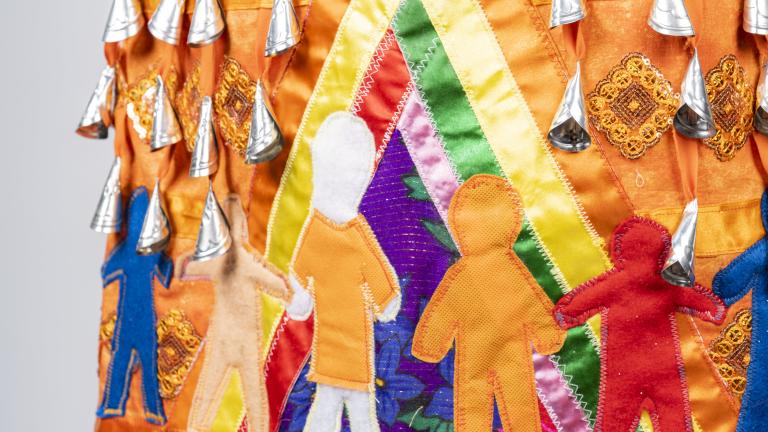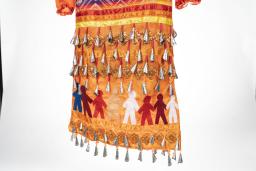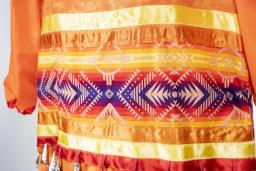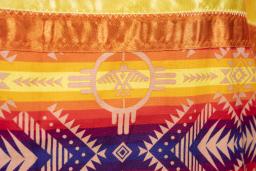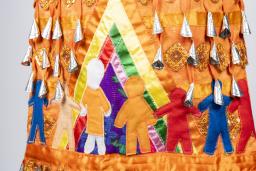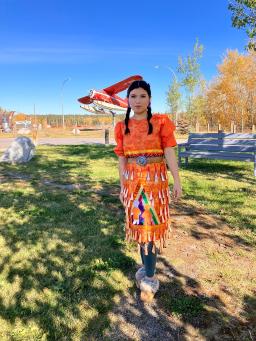Awasisuk will be open to the public starting February 28, 2023, in the Community Corridor at the Canadian Museum for Human Rights.
The Community Corridor is located in The Forks North Portage Partnership Classroom Lobby on the Main Level and can be viewed free of charge during the Museum’s hours of operation.
Project statement from Amanda Grieves,
Creator of Awasisuk
Awasisuk is about intergenerational healing and the process of moving forward to create not only a better future for ourselves but for our children as well.
Part of the inspiration for this piece is the “Every Child Matters” movement. When the news of discovering unmarked graves began to circulate, I saw a good deal of unhealed hurt and intergenerational trauma surface in many people in my community. This movement brought the truth to people across the world and with it an acknowledgement of the intergenerational trauma that residential schools and colonization have caused and continue to cause.
Through residential schools, children, including my parents, learned to suppress their emotions in order to keep themselves safe. This lesson was then passed on to me and my siblings. Whenever something difficult happened, we were told to keep our feelings to ourselves and stay strong for those around us, ultimately continuing this cycle of emotional suppression. Suppressing one’s feelings and lived experiences ultimately stops one from healing because if you can’t acknowledge what has happened to you, you can’t truly heal.
It was our Creator’s grace that carried me through my healing process, the same grace that carried my ancestors through. As part of my healing process, I continued to connect with my culture through dressmaking. This creative process helped me acknowledge the many beautiful parts of my culture. I hope to pass this beauty along to my children.
Awasisuk represents the healing journey and its importance, not only for ourselves but for the future generations as well. We can’t continue to hold onto the hurt of the past and our mistakes; we have to forgive ourselves and reach out for help when we need it. It is important to continue on this journey by being kind to yourself and releasing in a healthy way rather than becoming stuck dwelling on the grief and sorrow. By healing ourselves, we can move forward with good intentions for our children.
Awasisuk is sharing not only the difficult history of Indigenous people, but the resilience of our people and beauty of our culture as well.
About Amanda Grieves
My name is Amanda Grieves Bradburn. I am a dressmaker and I am a mother of 6 growing children. I was born and raised in Bunibonibee Cree Nation, also known as Oxford House.
My parents are Alan Dennis Grieves and my late mother, Roberta Grieves. I have work experience in the mental health and addictions area as well as certificates in trauma‐informed care. I am also a facilitator for the Circle of Reconciliation. I have showcased my artwork at the Health and Leisure Mart in Thompson.
I facilitate ribbon skirt workshops and volunteer my time and share ribbon skirt teachings at the homeless shelter and at 95 Cree Road. I have made and donated skirts to moms, youths and students in the community. I also made two jingle dresses, one in red and one in orange, in honour of Every Child Matters and MMIWG with the community during Indigenous Peoples Day festivities.
There are many social issues that were conditioned in our families; some may not be so positive and this may lead to the negative impacts of the cycle.
I know of these issues and have experienced them as a woman.
I have endured much grief and loss. It was a family breakdown that was almost too overwhelming that almost lost my hope.
I feel every person has a gift, but some may feel too far in grief and trauma that the feeling of hopelessness and lack of confidence may be blocking them to see their true potential.
As far back as I could remember as a child, my dad was a helper in my community, as well as my late Grandfather Rev. Vernon Grieves. I feel this is where I inherited my gifts of advocacy, to use my gifts to serve others that need the support. I use my creativity and I pass down my skills to other youth and mothers. This is where I want to use my voice to speak of self‐care, forgiveness, determination, love, truth and resilience, to use my gifts to empower others through creative expression.


